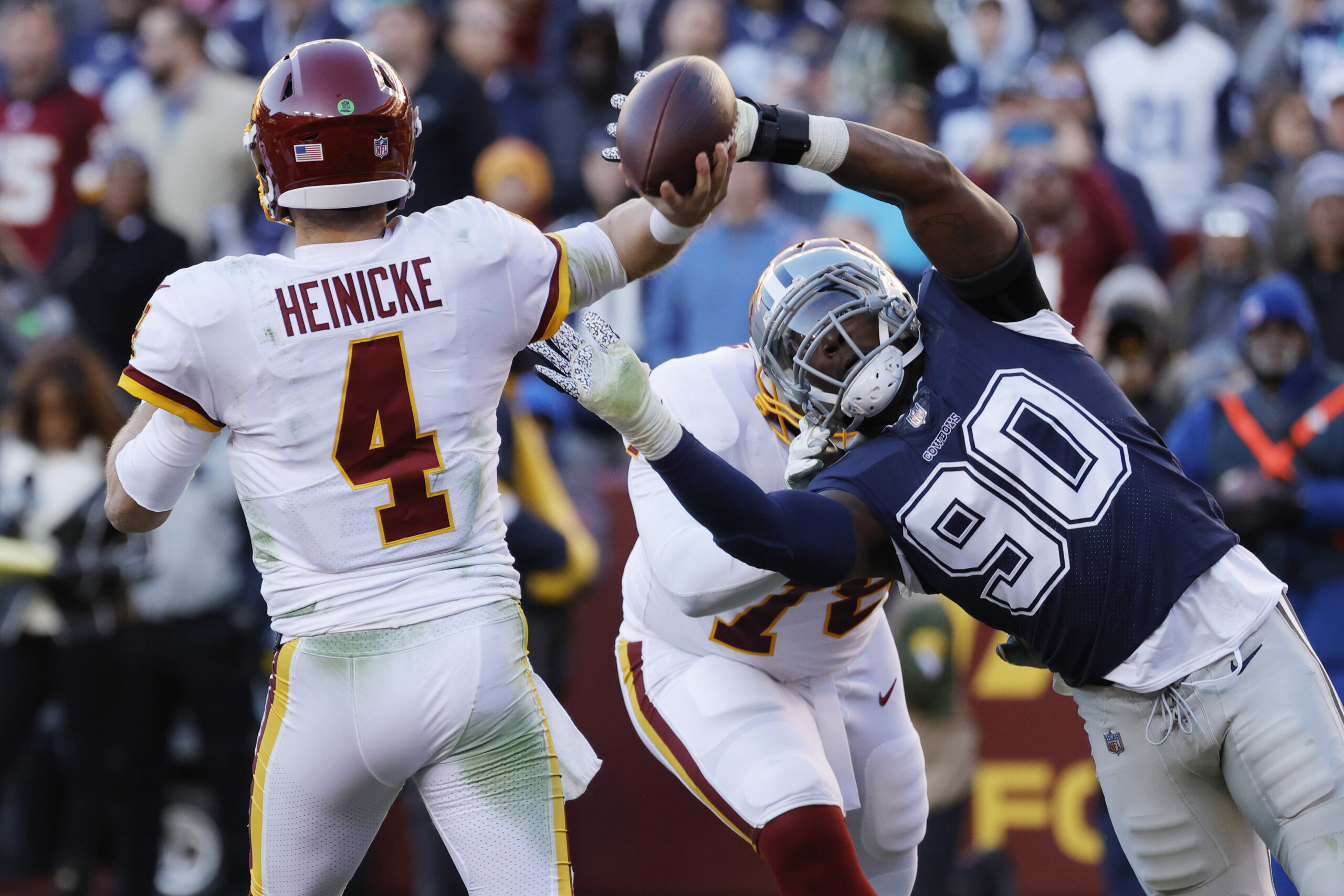In the extended Dallas Cowboys universe, the playoff destruction at the hands of the 49ers feels like three movies ago. Mike McCarthy openly said that Jerry Jones’ comments about the future of the coaching staff made it weird between McCarthy and his defensive coordinator, Dan Quinn. The club is knee deep in a scandal regarding payments to former cheerleaders stemming from the actions of a longtime stalwart executive. The word “upskirt” is being used in conversations about the team. The absurdities surrounding this organization never ceases to amaze me. They also never cease.
Given that dynamic, it can be easy to forget that the offseason also means the time on the calendar when rosters are actually refined and built. And for the Cowboys, more often than not, that means making sense of how they will get compliant with the league’s salary cap.
According to overthecap.com—an indispensable resource on these matters which we will reference a ton in this piece—Dallas is roughly $22 million over the 2022 salary cap. That’s the third-highest figure in the league. Simply put, as presently constructed, they will have to engage heavily in contract restructuring just to field a team, let alone retain any of their 21 pending free agents.
According to this chart, the #DallasCowboys can go from where they currently are — $24 million over the cap — to $49 million under the cap with simple restructures, and as much as $66 million under the cap with maximum restructures… https://t.co/OD2PcFbxO7
— Pat Doney (@PatDoneyNBC5) February 15, 2022
While it is true that the front office can wave its wand a few times and create a ton of cap space, I always wince a bit when the concept of restructuring is treated so flippantly. Not all restructures are created equally, for one thing, and it’s important to understand the pros and cons of trying it in the first place. No matter how it’s gone about, restructuring is perhaps the greatest window into what a front office believes about their current core. There are extreme examples of “all-in, devil-may-care” personnel decisions like the Rams just made on their way to a Super Bowl win. But the more common version of a “win now” approach can be seen in the degree to which teams engage in “kicking the can down the road” when it comes to their cap. That’s what’s on the line for Dallas, and there’s no totally clean way to go about it.
Two things before we proceed any further into the particulars regarding the Cowboys and how the pieces all fit together. First, no discussion of the team’s current financial situation should exclude the abject disaster that is the Ezekiel Elliott contract. Most people who don’t work for the Cowboys expected this the second Elliott signed it back in September 2019, even if the team’s logic for not wanting to relitigate this situation every offseason or, heck, every week of the season was understandable. Zeke’s 2022 salary became fully guaranteed last March. If there were a wing of the Hall Of Fame for agents, Zeke’s representation would have earned a bust based on this contract alone. I don’t fault Elliott or his agent for this; they have a right to go get paid. It was just financial malpractice for the team to do so on these terms, and the reality is Dallas is paying top-of-the-market money to a player who is at best average at his position. No matter what you may hear floated, there is nothing they can do about that mistake this offseason.
The other key component of this is a more positive one. Dallas is in this situation because they’ve consistently drafted really well—among the league’s best, in fact. Deciding how much and for how long to pay those players you hit on may be a separate matter. But “which of these good players we identified do we want to keep?” is a better problem to have than hoping you’re able to makeover your team with available free agents.
But how to go about it? For starters, it’s a near certainty that the Cowboys will restructure the contract of Dak Prescott in the next couple of weeks. This maneuver will create roughly $15 million in cap savings this season while increasing his cap hit by $3 to 4 million in each of the next four seasons. Which is fine. Slump or not, he’s a franchise quarterback in his prime, and the salary cap has resumed its regularly scheduled, pre-pandemic rise, with a big spike expected in 2023 with new TV deals kicking in. This is the safest possible can to be kicked.
From there, things get tricky. Dallas would still be $7 million over the cap and need about that much just to sign its draft class. Almost every player being mentioned as a possible restructure or cap casualty as a result of being cut has a corresponding player of the same position on the pending free agent list.
The wide receiver room has probably received the most attention, between Amari Cooper’s flexible contract and Michael Gallup due for a new deal. Cooper’s contract is such that Dallas could cut him now and save nearly $20 million. Meanwhile, Gallup’s injury-riddled 2021-22 season may force him to take a one-year “prove it” deal after once being projected to earn north of $10 million on a new contract. If so, perhaps he’d like to do that in Dallas. If not, it’s virtually impossible to imagine both Cooper and Gallup being Cowboys next season. The team can’t afford to lose both, and the most likely scenario is that they will restructure Cooper’s deal to save a substantial amount ($12 million) on this year’s cap. But it comes at a cost: this will effectively tie the team to Cooper for three more seasons, eliminating a lot of its flexibility.
The pass rush is even more complicated. DeMarcus Lawrence turns 30 in April and has a lengthy injury history. Free agent Randy Gregory is 29, and even if the previous off-the-field issues that led to multiple suspensions are behind him, the reality is that those suspensions mean he hasn’t played enough to make anyone fully confident that his recent production will continue. He won’t be cheap: Spotrac.com projects him to earn $13 million annually on his new deal. If Dallas wants both Lawrence and Gregory here next season, that will almost certainly include a restructure of Lawrence’s deal. Extending your commitment to a 30-year-old pass rusher in order to re-sign a 29-year-old pass rusher based solely on the one year you saw them significantly producing together would certainly be labeled as “all-in.” It could also be labeled as “incredibly reckless.” That’s not the only option, of course. Dallas could cut Lawrence and re-sign Gregory. They could also leave Lawrence’s deal as-is and let Gregory walk. In either case, they’d have to place edge rusher near the top of their draft board. And in either case, the defense they’d field next year would be worse on paper but also more financially solvent in 2024. These are the trade-offs that make this exercise so complicated.
(Just to address another solution you may have thought of: I think it would be a mistake for Dallas to simply make Micah Parsons a full-time edge player as a solution to this issue. Parsons has already proven that he can handle the week-to-week, series-to-series, down-to-down shuffling that makes him the most unique defensive talent in the game. Dallas’ lack of linebacker depth is part of this equation, but even if that weren’t a concern, I think there is tremendous value in having a player who keeps opposing offenses guessing while making them know they’re likely guessing wrong.)
Elsewhere, Connor Williams is free, and it’s possible that they’ve simply seen enough after four years. Maybe “The Other Connor,” McGovern, is a viable option at left guard, though I don’t see how anyone would consider that a surefire upgrade given their relative performances last season. Either way, the contracts of Zack Martin, Tyron Smith, and La’el Collins offer the most collective savings in terms of restructures. Given recent performance, Martin seems like a safe bet to continue performing at a high level, but at 31, who knows? Smith and Collins have played a combined 25 games over the last two seasons. Restructuring any of these deals would be dicey, as would moving on and trying to find their replacements. Some light maneuvering on Martin’s deal coupled with an in-house or replacement-level swap-in for Williams feels like the most likely scenario.
Tight end Dalton Schultz is in a different spot than the receivers or pass rushers. His valuation is in the $12 million range, but unlike with the receivers or pass rushers, the Cowboys would not be drafting or signing his replacement to be the second- or third-most important player at his position. They would need an immediate impact player. The Dallas offense was at its best last year when 12 personnel (one running back, two tight ends) was a viable option. Blake Jarwin’s injury took that club out of their bag, which directly resulted in the offense getting stuck in the mud. Given that Dallas will likely be replacing one wide receiver and at least one offensive lineman, adding tight end to that list would be a serious high-wire act. (Full disclosure: my brother works for the agency that represents Schultz, Caric Sports Management.)
However this plays out, Dallas did not hire Mike McCarthy or sign Prescott to a massive contract to start over or rebuild. This is a team with an owner/general manager who regularly talks about the limited time he has left on earth. While the Cowboys may not be candidates to add massive star power like the Rams did, that doesn’t mean they won’t put the pedal to the floor on keeping the bulk of last year’s team together while tinkering around the edges of the roster.
That might seem counterintuitive for a club that lost in the first round of the playoffs. But my sense is that the front office believes the personnel was good enough, and that they’re willing to say, “We’ll worry about 2024 in 2024” to double down on that bet. If it results in a couple of deep playoff runs—read: the most postseason success the Cowboys will have had in 25 years—it will be worth it. If it doesn’t, it probably makes the latter portion of Prescott’s career a painful watch. You may be able to circumvent the salary cap in the NFL for a while. But no one escapes its impact forever.
Get the ItList Newsletter
Author






